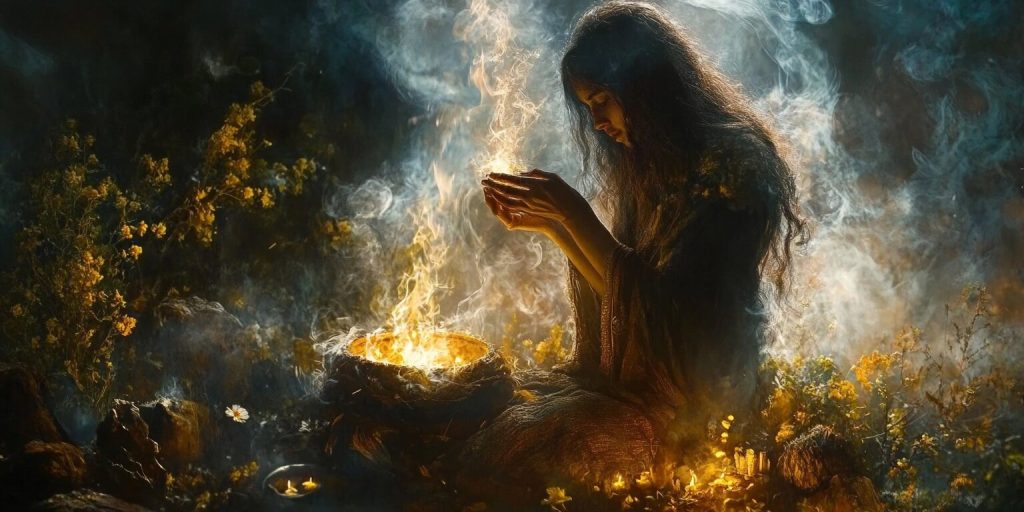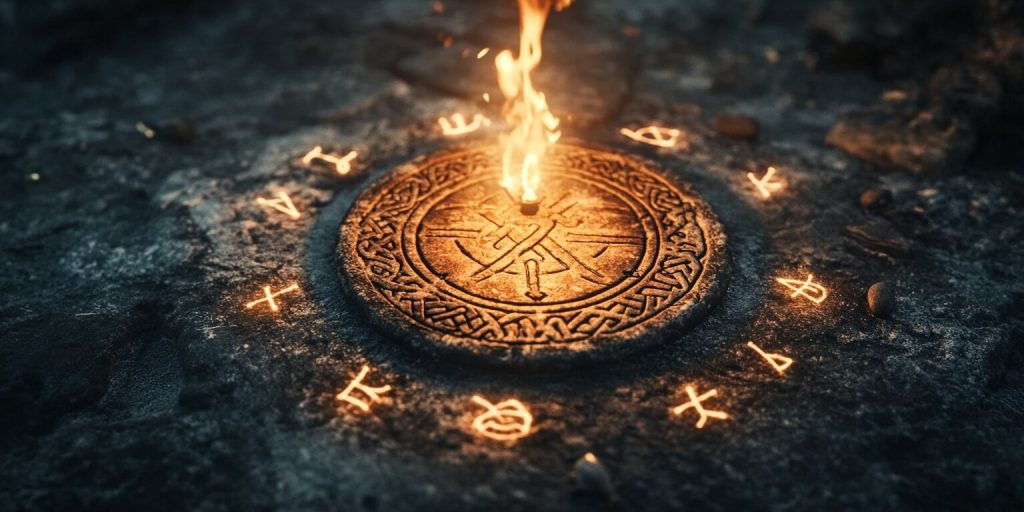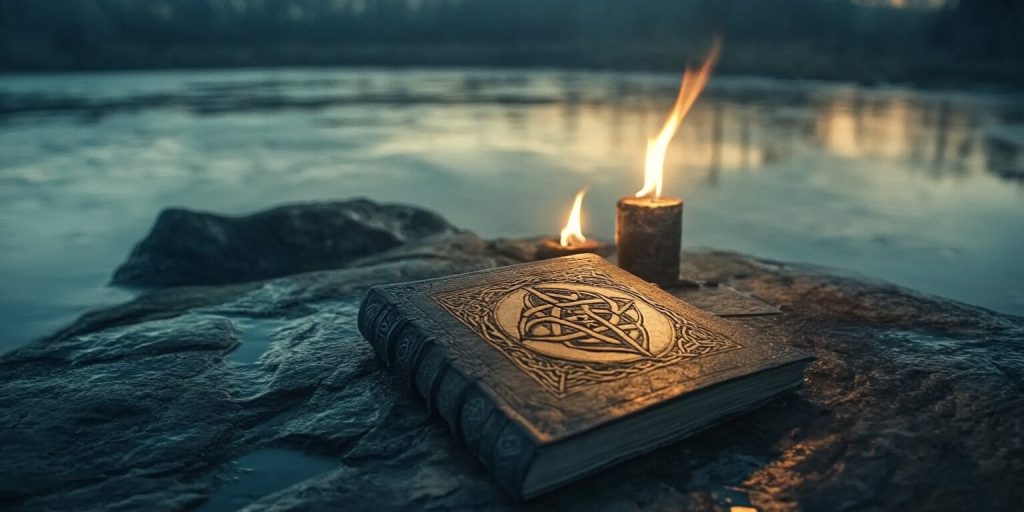Norse Mythology, Norse Runes, Viking Heritage
Exploring the Types of Norse Magic: From Seiðr to Rune Spells
The world of Norse magic is fascinating. It reveals the spiritual practices of Viking culture and Norse mythology. Knowing the different types of Norse magic is vital to understanding Norse paganism.
This journey will focus on important magical practices, including seidr and other forms of magic. We’ll look at Seiðr, rune magic, and galdr. These spells and rituals were deeply rooted in tradition and held great significance.
Studying the Eddas and Sagas reveals the role of magic in Norse life. It was a big part of their daily lives and spiritual paths.
Introduction to Norse Magic
Norse magic is a part of Viking life and culture. The Norse word for magic is seiðr, which shows a deep tradition of rituals and mysticism. These practices were a big part of daily life, affecting farming and war.
Magic had many uses in Nordic traditions. It was used for power, protection, healing, or seeing the future. Many stories show how magic changed lives and fates.
Learning about Norse magic helps us see its role in society. It shows how people connected with nature and the supernatural. This view blended the natural world with magic, highlighting the significance of runic magic.
The Significance of Magic in Norse Mythology
Norse mythology is all about magic, showing a deep bond between gods and the mystical. The Vikings believed in Norse pagan magic, which shaped their view of the world. The stories of the Norse gods were key to their magic practices.
The Role of Norse Gods in Magical Practices
Odin and Freyja were key figures in Norse magic. Odin was wise and sought mystical powers. With his deep spiritual knowledge, he led rituals.
Freyja, on the other hand, was about love and fertility. People called on these gods in rituals, asking for their help in magic and nature. This shows how much the Vikings respected their gods’ power over life and death.
Connections to Norse Paganism
Norse pagan magic was part of Norse paganism. This belief system was a big part of Viking life, mixing spirituality with culture. Magic was not just for personal use but was a shared identity.
Rituals were often done together, showing a bond with the gods and their magic. Society greatly valued magic, using spells for protection, healing, and even changing fate. This made Norse pagan magic a big part of their spiritual lives.
Understanding Seiðr
Seiðr is a unique part of Norse magic. It connects deeply with the spiritual and cultural sides of Viking society. Its origins and history show its importance in Norse witchcraft and how it shaped daily life.

Origins and Historical Context
Seiðr comes from ancient Norse societies. It was a way to connect with the spirit world. Old records say it started from shamanistic traditions, vital in pre-Christian Scandinavia.
This practice helped people talk to deities, spirits, and ancestors. They often sought guidance or tried to predict the future.
Seiðr Practices and Rituals
Seiðr involved many rituals, focusing on trance-like states and group gatherings. Women, called völvas, played a big role. They led ceremonies, using their power to connect the living with the divine.
Rituals included:
- Invocations of deities and spirits
- Use of chants and music to induce altered states of consciousness
- Forensic divination to decipher omens and messages
These rituals let practitioners of seiðr use Viking magic. They faced personal and community challenges, showing the strength and flexibility of Norse witchcraft through time.
Types of Norse Magic
Norse magic is a rich mix of practices. It shows the many beliefs and customs in Norse mythology. This part discusses the different types of Norse magic, their special elements, and how practitioners use magic, particularly in Scandinavian contexts.
Overview of Different Magical Practices
There are many types of Norse magic. People often practiced:
- Seiðr: This magic is about changing states of mind and seeing the future.
- Rune Magic: It uses runes for protection and to cast spells. Runes have deep meanings and symbols.
- Galdr: It’s based on chanting and sounds. It tries to change nature with spells and chants.
Distinct Elements of Each Type
Each type of Norse magic has its special things:
- Seiðr deals with fate and changing the course of life.
- Rune Magic uses symbols to call on powers or meanings.
- Galdr uses sound and words to make a direct impact.
These different magic types show how Vikings approached the supernatural. No one magic type was more important; each had its role, showing the complexity of Norse beliefs.
Rune Magic: The Power of Runes
Rune magic is key in Norse culture. It mixes language and mysticism. The runes’ power comes from their history and deep meanings.
Ancient Norse people saw runes as more than just symbols. They believed runes could change life, like bringing protection or luck.
Historical Use of Runes
Runes started being used in the early Common Era, when Viking magic grew, particularly in the context of Germanic traditions. Runes were used for talking and magic.
Each rune had its energy and meaning. The Norse used runes on stones and weapons, believing they could summon supernatural powers.
Inscribing Runes for Spells
Writing runes was key in rune magic. It made spells work better. People carved runes into wood, stone, or metal.
They focused their will on the runes’ power. Specific runes were used for love, healing, or protection, making them powerful tools in Viking magic.
Galdr: The Art of Incantation
Galdr is a special part of Norse magic. It uses incantations to create powerful spells. This shows how the Norse saw language as a tool to change reality and connect with the unknown through runic magic.
Methods of Performing Galdr
There are key ways to make galdr work better. Practitioners use:
- Vocal techniques: Getting good at pitch and rhythm make the spell stronger.
- Musical accompaniment: Lutes or drums add a special vibration.
- Repetition: Saying the incantations over and over boosts the spell’s energy in the practice of seidr.
These methods show Galdr’s mix of art and spirituality.
Examples of Galdr in Norse Literature
Norse stories give us many examples of galdr. They show the amazing power of Viking age traditions. For example, the Poetic Edda tells of:
- Invoking protection: Warriors would chant to protect themselves in battle.
- Summoning aid from deities: Incantations to gods were used for help in hard times.
- Shaping destiny: Practitioners tried to change their fate for the better.
These stories show Galdr’s big role in Norse culture. They show how words, sound, and willpower work together in magic.
Shamanism and Norse Magic
Shamanism is key in Norse magic and is linked closely with Viking culture. Shamans, or gåters and völvas, connected the physical and spiritual worlds and guided people through mystical experiences.

Their power to cross reality’s boundaries was crucial. It helped them fulfill important roles in their communities.
Role of the Shaman in Viking Culture
Shamans had many roles in Viking culture. They were respected for their knowledge and healing skills. Communities looked to them for:
- Guidance through spiritual journeys: Shamans went on transformative trips. They met spirits to gain wisdom.
- Healing rituals: They used magic to heal the body and spirit, showing the link between health and the spiritual world.
- Protection against malevolent forces: They performed rituals to protect people from harm.
Spiritual Journeys and Healing Rituals
Spiritual journeys were central to shamanic practice. Shamans explored these realms through drumming, chanting, and trance, seeking to connect with divine beings for insight.
Healing magic used nature’s elements, such as herbs and stones, which were believed to have special powers. This approach united body and spirit, offering a deep understanding of health.
The Influence of Eddas and Sagas
The Eddas and sagas give us a deep look into Norse magic. They are key sources of information, filled with magic stories that show how magic was part of daily life.
Magic Narratives in Old Norse Literature
The Eddas and sagas contain many magic stories. These stories show characters using spells and talking to gods, helping us understand Norse values and magic’s role in their lives.
Themes like fate, power, and human-god relations are common. They show the depth of Norse mythology.
Lessons on Magic from Historical Texts
The Eddas and Sagas teach us about Norse magic. They show how magic works and its ethics. Characters face consequences for their magic, teaching us about responsibility.
These texts are both historical and cultural treasures. They help us understand magic today and keep Norse beliefs alive.
Magic and Healing in Norse Society
Norse society highly valued magic and healing. They used many methods to understand physical and spiritual health, showing how important healing magic was for getting well.
They used herbal remedies, protective spells, and talismans as part of their magic practice, divided into two main areas: the real and the symbolic.
Healing Practices and Herbal Remedies
Herbal remedies were vital in Norse healing. They used plants and roots from the land. This showed their deep connection to nature.
Some popular herbs were:
- Chamomile: Known for its calming properties.
- Yarrow: Often utilized for wound healing.
- St. John’s Wort: Valued for its mood-lifting effects.
They mixed these herbs with magical powers to strengthen them. Practitioners used incantations and rituals, which helped heal the body and spirit together.
Protective Spells and Talismans
Protective spells were also important. They kept people safe from harm. These spells called on gods or spirits for help.
Talismans were another way to protect. They were made with special intentions. Some common talismans were:
- Runestones: Engraved with runes for protection.
- Necklaces: Worn to ward off negative energies.
- Herbal pouches: Containing protective herbs pinned to clothing.
This mix of magic and protection showed how Norse culture cared for health and spirit. It made life richer, ensuring people looked after their bodies and souls.
The Christianization of Scandinavia and Its Impact on Norse Magic
The Christianization of Scandinavia deeply changed the culture and beliefs, influencing the practice of Norse religion. As people moved from paganism to Christianity, it greatly affected Norse magic. The mix of old and new beliefs changed magic in many ways.

Transition from Paganism to Christianity
The change from paganism to Christianity was slow and influenced by politics and missionaries. As churches grew, many Norse people started believing in Christianity, which affected their understanding of Norse religion.
This change made them see the world differently. Old gods and rituals were replaced, but some traditions stayed. This showed both sides of the shift, from resistance to acceptance.
Adaptation of Magical Practices
Norse magic showed its strength during this time. Many old spells and rituals were seen in a new light. For example, charms and healing practices used Christian symbols and saints.
This mix kept Norse magic alive as beliefs changed. It helped practitioners keep their identity in a new religious world, preserving their Germanic roots.
Modern Interpretations of Norse Magic
Norse magic has greatly changed, showing a new interest in old ways. People mix old texts, rituals, and customs with modern life, making new magic by combining ancient beliefs with their own stories.
Revival of Norse Paganism Today
More people want to connect with their Viking roots. Modern Norse magic helps them do this, drawing from ancient practices like seidr. It brings ancient Viking ways into today’s world.
People meet, share rituals, and talk online. This helps them learn and grow together. It’s a supportive place for those starting their spiritual journey.
Contemporary Witchcraft and Norse Practices
Witchcraft today often includes Norse traditions. This shows how old ways can fit into the new world. People use Norse magic in many ways, like:
- Rituals that honor gods and nature.
- Runes for divination and magic.
- Herbal remedies and natural items in magic.
- Exploring personal spiritual paths from old stories.
This mix of old and new creates a lively space. It allows people to practice witchcraft today while respecting Norse traditions, showing how Norse magic is still important today.
Conclusion
Norse magic is a big part of Norse mythology. It shows how the gods, rituals, and nature are connected, creating a rich world of beliefs that has grown over time.
From shamanism to rune spells, these practices were vital in Viking society and reflected their type of magic. They helped shape how people saw the world and themselves.
This look at Norse practices shows how magic has lasted through time. Even though things have changed, the heart of these practices stays strong. Exploring these traditions helps us understand their role in daily life and how they shaped society.
The magic of the Norse people is still alive today. It inspires many who seek to connect with the past. Norse magic is not just old stories; it’s a living part of our spiritual journey.

